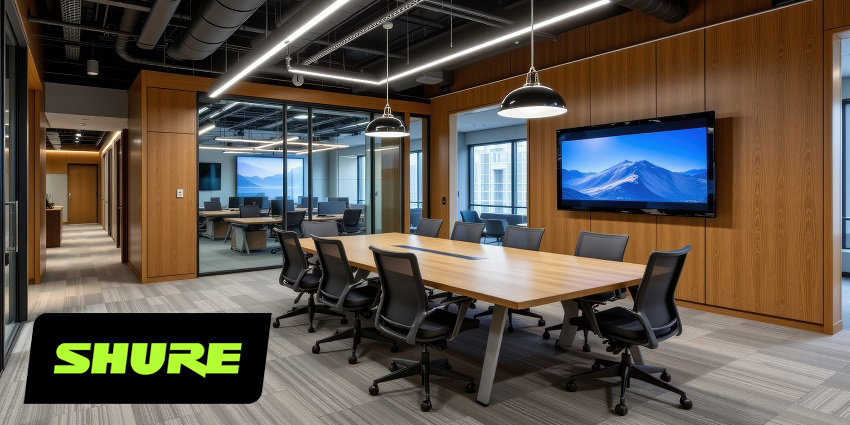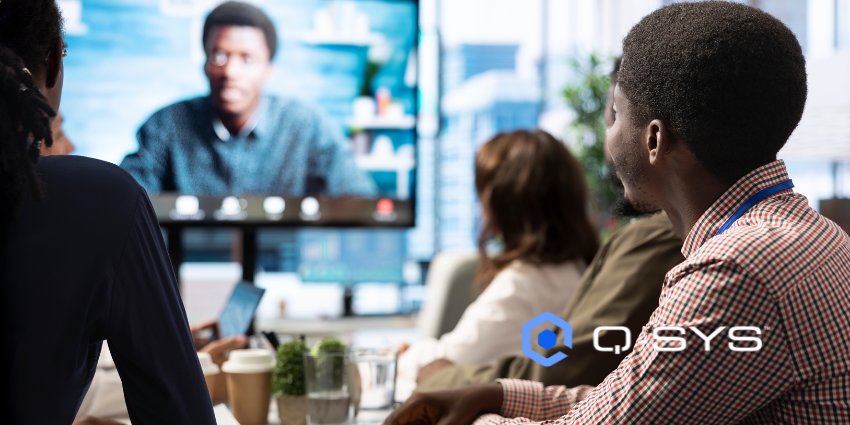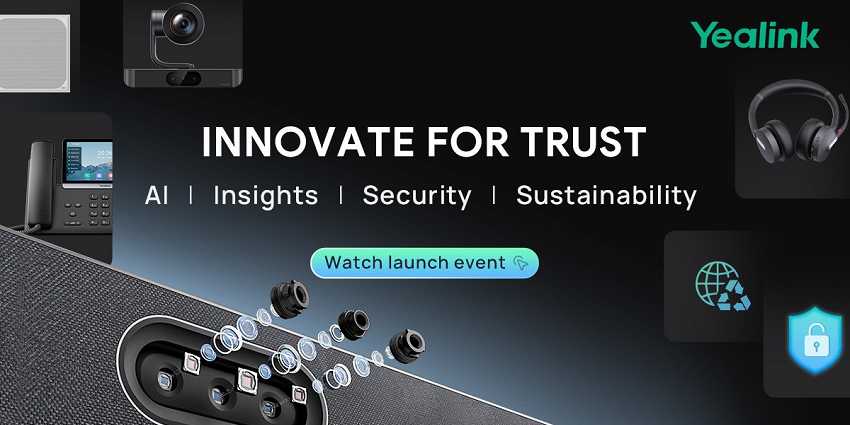If you could design the AV infrastructure of an entire building from scratch, how would you do it?
It sounds like a job interview question or a casual ice-breaker at a conference, but it was also the challenge (and opportunity) handed to Ben Pain, Head of AV Resources at the Royal College of Physicians, a few years ago when the hallowed medical education institution in London began planning its second site in Liverpool.
“Liverpool was a greenfield site where I was given a certain amount of free reign to imagine what I would do if I were building an AV service in the building,” Pain told UC Today. “We spent about £1 million on the AV as we built it across all the floors. We brought in some really interesting things, like Q-SYS and similar technologies.”
“We have many multi-use spaces in London, and we knew we were going to have many multi-use spaces in Liverpool as well, which could be used for education, training, conferences, dinners, drinks, receptions, etc. One of the challenges that we have felt most keenly in London is the ability to transform the spaces from one type to another in a short period of time.”
“During the design brief for Liverpool, we wanted to have more built-in AV but the same sort of flexibility that you might expect if you’re just putting in temporary equipment all over the place.”
Pain and his team collaborated with a design consultancy called Recursive and attended ISE for several years, where they talked with “lots of different brands and started to understand a little bit about how ecosystems were being formed around the Q-SYS platform”. The Royal College of Physicians (RCP) also worked “very closely” with Sennheiser on the microphone side, particularly for the Liverpool building, which eventually opened in 2021 and was named the Spine.
Ultimately, Pain’s design brief to Recursive was that he wanted every endpoint in every room accessible from any other room within the AV estate.
“So, if you’ve got a camera on the ground floor, you can route that camera to the screen in our 13-floor lecture space,” Pain outlined. “If I want to pick up the audio from that space as well, I can do that. We can do that all through a central GUI designed for us using the Q-SYS platform as a basis. We’ve got Q-SYS cores on all six of our floors. Those Q-SYS cores are all talking to each other. The video control runs through Q-SYS. The audio control runs through Dante, but then obviously is also fed through Q-SYS that way.”
“It just means all the meeting rooms have Sennheiser ceiling tiles, and a couple of them have the little Biamp microphone, just because we had a design need for something different from the ceiling tiles. They all have PTZ cameras. We’ve got ingest points for USB and USB-C in all the rooms, so if you plug a laptop into any of our meeting rooms, the meeting room suddenly becomes your camera, microphone, and screen, which is really nice. That level of flexibility was really, really important to us.”
Pain affirmed that the College wanted the building to promote well-being as much as possible, so the AV team wanted the technology to be stress-free and unobtrusive.
Pain’s Story So Far And Compelling Challenges
Pain joined the RCP 12 years ago, initially as its first AV Manager, before donning his current title. Managing 19 staff across both the Liverpool site and London’s St. Andrew’s Place—the RCP’s brutalist-designed home since 1964 and the youngest grade one listed building in the country—his team produces videos, webinars, and other similar tasks, as well as overseeing installations and projects.
“The college seems to touch every vertical in one way or another,” Pain explained. “We are primarily a membership organisation with 40,000 members. We’re also a registered charity, a postgraduate education organisation, and a provider of health care policy and advice to governments. We are a research and standards body; we also have small museum status and are a commercial venue.”
“I sometimes say that we’re a membership organisation posing as a charity pretending to be an HE organisation while trying to be a corporate.”
Managing the AV infrastructure for such an old and storied institution presents challenges. St. Andrew’s Place has limitations as a listed building, which Liverpool’s new site does not. However, the best practices learned from Liverpool could inform similar strategies in London.
“The estates are completely different,” Pain said. “What we did find was that because Liverpool was a greenfield site, we were able to have discussions with our partners in IT and property services that we might not have been able to have if the building had been operational at the same time. Because the first two years of discussion about the design were on paper, suggesting things we weren’t doing before was easier.”
“This whole idea of putting all the AV on the network—there was more resistance when we discussed it in London before we started work on Liverpool. Once people saw the benefits of Liverpool, it was easy to go back and say, ‘Right, okay. We can now start the iterative process of implementing the learning from Liverpool into London. But we appreciate it’s going to have to be a gradual process.'”
“So, the base concepts and the base levels of knowledge are now in place across all our teams. What we have now is finding the time in the building, which is still quite busy, to do the work.”
Another unique challenge for Pain and his team is making the sophisticated AV setup as user-friendly as possible for users who might not be too tech-savvy. Thankfully, Pain and his team are diligently on hand to support both the Liverpool and London spaces.
“The team in Liverpool will do regular testing in all spaces,” he explained. “They will provide some kind of white-glove service so that you’ll always get a technician to come in the morning and say, ‘Hi, how are you doing?’ If it’s a relatively simple education course, then most of our educationalists are also familiar with the rooms, which makes it easier for us. It just means that we can go in and ask, ‘Everything fine?’ Yeah, absolutely fine.’ Move on to the next one.”
“When we’re running about 300-person conferences in one space, we will treat it as a full AV production and act like an external AV company as opposed to a support thing.”
The Rise Of AI And Grappling With Hybrid Work And Learning
Balancing technological innovation with an intuitive user experience is a challenge as old as time for IT leaders, but AI is an entirely different proposition. Have Pain and his team dabbled in leveraging AI across their systems?
“We’re right at the start of the journey,” he said. “What we’re focused on is largely around education. It’s explaining to colleagues in finance and IT, etc., the benefits of it, the cases in which we’re already using AI, but maybe not calling it that. Starting to get them to work on a risk register and a programme of works over three, four or five years that will get us to a point where we can realise some of the benefits.”
“Some of our partners on the medical side are obviously very interested in how AI can improve health care. But there’s been less engagement, I think, about how AI can improve our day-to-day function as a business and an organisation.
“That’s where some of the colleagues from across the college and I are now starting to work together to say, ‘Okay, well, what can we do?’ So, a small cohort of us have been using ChatGPT for a while and are just playing with it and understanding how that will make a difference to us. Our IT colleagues have started to roll out Copilot. So we’re actively looking to see what Copilot can do to make some of the things we do more effective.”
What about the more AV-specific AI applications?
“In Liverpool, you’ve already got the Q-SYS platform involved,” Pain said, “and we’re going to start to take some steps about how we can use some of their AI tools around tracking people and knowing where people are on the stage and stuff like that.”
Pain stressed the importance of AI’s impact on GDPR for the RCP as a membership-based organisation, meaning it’s also “kind of a public body in that sense”. Anything that entails collecting a person’s data, such as AI-powered face or voice recognition, must undergo a stringent process of checks before proceeding.
On the Gen AI side, Pain and his team use ChatGPT to write better business documents, summarise meetings and create action points, i.e., “the parts of the job I used to really dislike”.
He has also started using Copilot more to aggregate data.
“One of the things we do have at the moment, particularly in London, is many different IT systems that don’t necessarily talk together very well,” Pain explained. “AI just allows us to start bringing data strands together in a way that improves the efficiency of the business and the way that we do things.”
“In terms of AV, beamforming technology in the microphones that we have in a lot of our spaces now is part AI in the way that it works; understanding where the noise is and being able to create noise-cancelling dynamically is really helpful.”
The other major change that every organisation has had to grapple with in recent years has been the rapid rise of hybrid and remote work. How was the College’s adaptation to the pandemic—and the enforced challenges around hybrid learning and remote work? Smooth, it turns out, because they’d been preparing for hybrid and remote functionality for several years.
“We worked on two projects from about 2016 to 2019. One was to make our main lecture spaces hybrid because we have quite a large international cohort of members,” Pain said. “We were also conscious that even prior to the pandemic, many doctors found it difficult to attend face-to-face meetings. So we wanted to make sure that we had this option for people to come in.”
“We had literally just finished moving from Skype for Business to an early version of Teams for Business in January 2020,” Pain continued. “So when the pandemic hit, we were already able to send all the staff home with a laptop, and their laptop was their phone. Their laptop was their videoconferencing device.”
As with many other organisations, the RCP had an incredibly brief adoption curve to overcome. Some of the longer-serving staff members were initially nervous about the new ways of working. However, the number of support calls that Pain and his team covered went from roughly 30 a day in March to none by May because “Everybody’s on. ‘I get it now,'” Pain said.
“We were just planning to run our annual conference, Medicine, in February 2020, which we normally run in April or May,” Pain said. “We obviously knew that we couldn’t. So we quite quickly worked with our colleagues in the conferences team and a third-party company called Groovy Gecko, who do some of our video stuff for us. We built an on-demand platform for our members, which is still running. It’s called the RCP player.”
“The pivot to virtual at the start of the pandemic was really, really smooth for us. Weirdly, the pivot back via hybrid to wherever we are now has been much more complicated.”
Why was that?
“The first pivot was quite easy because you had no choice,” Pain said. “You knew it was going to have to be virtual. Then you had this thing where you had some companies going, ‘Well, virtual and hybrid, it’s the future, and it’s going to stay,’ and you had other organisations going, ‘No, no, no, face-to-face is going to have to come back because of this, this, this and this.'”
Pain felt the discussion was reductive.
“It was very much an either-or situation: you’re either modern and doing hybrid or old-fashioned and doing face-to-face,” he argued. “You’ve suddenly given event planners, organisations, and anybody with a vested interest a whole load of new tools, but the sophistication of understanding when each of these tools is applicable took a little bit longer.”
“That’s been the bit for us. It’s a case of all these new things now. We don’t have to use them all at once. We have to be much more selective and strategic about when we use virtual, if and when we use hybrid, and when we do face-to-face.”
Pain suggested that, in his experience, the hybrid aspect is struggling to find a niche. There’s a substantial market for virtual webinars, and people like to collect bits of didactic presentation content at a time that’s easy for them. People also like to meet with their peers and have a drink, have face-to-face chats, meet exhibitors, and meet sponsors.
“What you don’t really want is a half-and-half situation where neither side of that equation really gets what they asked for,” Pain said. “Actually, supporting clients, both internally and externally, who are still struggling with the right thing to do has probably been more of a challenge than guiding them towards the only choice they had at the start of the pandemic.”
What Would Support Pain And His Team?
Managing a complex AV ecosystem across two estates can be challenging. Are there any features or solutions that Pain would like to see from vendors that could greatly support him and his team?
“When people bring platforms to market these days, they focus a lot more on interoperability and strong APIs,” he outlined. “I think the College is still reliant on a few platforms from an older era, where the platforms’ designs and back ends are much more proprietary.”
“So, as the people in people and culture, finance, IT, and all the other parts of the College start to review the platforms where the data is kept, we are now becoming a little bit smarter, I think, at finding platforms that are much more efficient at sharing information that they are gathering. I think that’s the way it’s going to go.”
Pain mentioned that his friend (Ved Sen, Head of Innovation at Tata Consulting, UK & Ireland) wrote a book (Doing Digital: The Guide to Digital for Non-Technical Leaders) arguing that the idea of having one major piece of software to do everything is going to be replaced by having lots of little bits of software that do things very well and are much better at talking to other bits of software. Pain agrees with this prediction.
“When that happens, and the APIs are more effective, and you can plug all those APIs into a framework like Office 365 or an equivalent and then use AI to pull strands of data from each of these different specialist platforms, then I think that will make things a lot easier for us,” Pain said.
“What we don’t want to lose on the event side is the human bit. We still want to make people feel that they’re talking to other people in a real way. So, we’re very mindful on the AV side that the human touch is not something we want to totally eliminate.”







